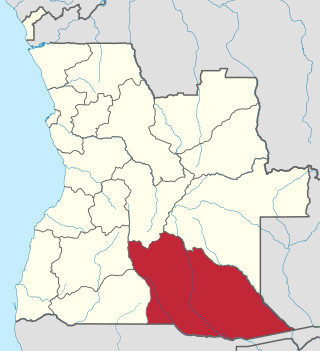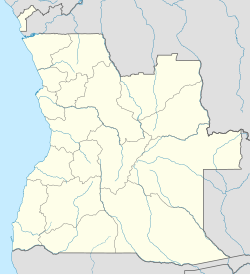
Bié is a province of Angola located on the Bié Plateau in central part of country. Its capital is Kuito, which was called Silva Porto until independence from Portugal in 1975. The province has an area of 70,314 square kilometres (27,148 sq mi) and a population of 1,455,255 in 2014. The current governor of Bié is José Amaro Tati.

Cuando Cubango is a province of Angola and it has an area of 199,049km2 and a population of 534,002 in 2014. Menongue is the capital of the province. The governor of the province is José Martins, who was appointed governor in November 2021.

The Angolan Civil War was a civil war in Angola, beginning in 1975 and continuing, with interludes, until 2002. The war began immediately after Angola became independent from Portugal in November 1975. It was a power struggle between two former anti-colonial guerrilla movements, the communist People's Movement for the Liberation of Angola (MPLA) and the anti-communist National Union for the Total Independence of Angola (UNITA).
The Battle of Cuito Cuanavale was fought intermittently between 14 August 1987 and 23 March 1988, south and east of the town of Cuito Cuanavale, Angola, by the People's Armed Forces for the Liberation of Angola (FAPLA) and Cuba against South Africa and the National Union for the Total Independence of Angola (UNITA) during the Angolan Civil War and South African Border War. The battle was the largest engagement of the Angolan conflict and the biggest conventional battle on the African continent since World War II. UNITA and its South African allies defeated a major FAPLA offensive towards Mavinga, preserving the former's control of southern Angola. They proceeded to launch a failed counteroffensive on FAPLA defensive positions around the Tumpo River east of Cuito Cuanavale.

The South African Border War, also known as the Namibian War of Independence, and sometimes denoted in South Africa as the Angolan Bush War, was a largely asymmetric conflict that occurred in Namibia, Zambia, and Angola from 26 August 1966 to 21 March 1990. It was fought between the South African Defence Force (SADF) and the People's Liberation Army of Namibia (PLAN), an armed wing of the South West African People's Organisation (SWAPO). The South African Border War was closely intertwined with the Angolan Civil War.
Operation Displace was a military operation by the South African Defence Force during the South African Border War and Angolan Civil War. It involved maintaining the illusion that the SADF had remained in brigade strength east of Cuito Cuanavale at the end of April 1988 and the eventual withdrawal of all South African military units from south-eastern Angola during August 1988.
Operation Wallpaper was a military operation by the South African Defence Force (SADF) during the Angolan Civil War and South African Border War.
Operation Alpha Centauri was a South African military operation during the Angolan Civil War and South African Border War to halt an offensive launched by the People's Armed Forces of Liberation of Angola (FAPLA) towards Angola's Cuando Cubango Province. Its objective was to prevent FAPLA forces from reaching Jamba, a strategic town which functioned as the de facto headquarters of the National Union for the Total Independence of Angola (UNITA) and its armed wing.
Operation Hooper was a military operation in 1987-88 by the South African Defence Force (SADF) during the South African Border War. This operation forms part of what has come to be called the Battle of Cuito Cuanavale. The Cubans' objective was securing the town of Cuito Cuanavale on the west of the river from capture. The SADF objective was to drive the People's Armed Forces for the Liberation of Angola (FAPLA) west across the river or to destroy them, so as to ensure that FAPLA was no longer a threat to the National Union for the Total Independence of Angola (UNITA) in the south-east. The FAPLA advance was permanently halted, UNITA lived to fight on for another 15 years. The SADF never attempted to capture the town. Both sides claimed victory.
Operation Packer was a military operation by the South African Defence Force (SADF) during the South African Border War and Angolan Civil War from March to April 1988. This operation forms part of what became known as the Battle of Cuito Cuanavale. Operation Packer was a continuation of Operation Hooper, using fresh troops and equipment. The Cubans' objective was still to secure the town of Cuito Cuanavale to the west of the river from capture. The SADF objective was once again to eliminate the remaining Angolan forces on the east side of the river, so as to ensure that the Angolans were no longer a threat to UNITA in the south-east. Although at the conclusion some Angolan units remained in positions east of the river, the Angolan advance against UNITA was permanently halted, and UNITA lived to fight on. The SADF never attempted to cross the river or to capture the town. Both sides again claimed victory.
In the 1980s in Angola, fighting spread outward from the southeast, where most of the fighting had taken place in the 1970s, as the African National Congress (ANC) and SWAPO increased their activity. The South African government responded by sending troops back into Angola, intervening in the war from 1981 to 1987, prompting the Soviet Union to deliver massive amounts of military aid from 1981 to 1986. The USSR gave the Angolan government over US$2 billion in aid in 1984. In 1981, newly elected United States President Ronald Reagan's U.S. assistant secretary of state for African affairs, Chester Crocker, developed a linkage policy, tying Namibian independence to Cuban withdrawal and peace in Angola.

Relations between Angola and South Africa in the post-apartheid era are quite strong as the ruling parties in both states, the African National Congress in South Africa and the MPLA in Angola, fought together during the Angolan Civil War and South African Border War. They fought against UNITA rebels, based in Angola, and the apartheid-era government in South Africa which supported them. Nelson Mandela mediated between the MPLA and UNITA during the final years of the Angolan Civil War. Although South Africa was preponderant in terms of relative capabilities during the late twentieth century, the recent growth of Angola has led to a more balanced relation.

The Cuban intervention in Angola began on 5 November 1975, when Cuba sent combat troops in support of the communist-aligned People's Movement for the Liberation of Angola (MPLA) against the pro-western National Union for the Total Independence of Angola (UNITA) and National Liberation Front of Angola (FNLA). The intervention came after the outbreak of the Angolan Civil War, which occurred after the former Portuguese colony was granted independence after the Angolan War of Independence. The civil war quickly became a proxy war between the Eastern Bloc led by the Soviet Union and the Western Bloc led by the United States. South Africa and the United States backed UNITA and the FNLA, while communist nations backed the MPLA.

During Angola's civil war, Cuban forces fought alongside the Marxist–Leninist People's Movement for the Liberation of Angola (MPLA) government; against the Western-backed National Union for the Total Independence of Angola (UNITA) and National Liberation Front of Angola (FNLA) guerrillas who were aided by the South-African army. The present day outcome of the war resulted in the MPLA changing from a Marxist–Leninist party to a multi-party democratic system based on neoliberal principles. From an economic standpoint, Cuba has lost its preferred status among Angolans and South Africa has become the biggest single investor and trading partner with Angola.
The Brazzaville Protocol mandated the withdrawal of Cuban troops from Angola, paving the way for Namibia's independence through the New York Accords. Representatives from the governments of Angola, Cuba, and South Africa signed the protocol on December 13, 1988 in Brazzaville, Congo.

The People's Armed Forces of Liberation of Angola or FAPLA was originally the armed wing of the People's Movement for the Liberation of Angola (MPLA) but later (1975–1991) became Angola's official armed forces when the MPLA took control of the government.

The People's Republic of Angola was the self-declared socialist state which governed Angola from its independence in 1975 until 25 August 1992, during the Angolan Civil War.
Mavinga is a town and municipality in Cuando Cubango Province in Angola. One of the three municipalities in Angola. Predominantly inhabited by the Mbunda and municipality had a population of 27,196 in 2014. It comprises the communes of Mavinga, Cunjamba/Dime, Cutuile and Luengue.

The 1985 Aeroflot Antonov An-12 shoot down occurred on November 25, 1985, in Angola during the Angolan Civil War and South African Border War. An Aeroflot Antonov An-12BP cargo aircraft operated by the Soviet Air Force flying from Cuito Cuanavale to Luanda was shot down, allegedly by South African Special Forces, and crashed approximately 43 kilometres (27 mi) east of Menongue in Angola's Cuando Cubango province.
Operation Excite/Hilti was a set of military operations by the South African Defence Force (SADF) during the Angolan Civil War and South African Border War.










